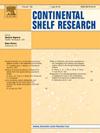巴西东南部~ 30年人工鱼礁的生态作用和生产潜力
IF 2.2
3区 地球科学
Q2 OCEANOGRAPHY
引用次数: 0
摘要
人工鱼礁(ARs)增加了以前具有均匀松散底物的地区的异质性,通过提供更多的反捕食避难所,有利于幼鱼的生存。人工栖息地增加鱼类丰度和减少渔业影响的功效取决于它们作为鱼类生物量的吸引者或生产者的功能。本研究试图阐明1996年在巴西里约热内卢北部海岸安装的珊瑚礁综合设施的潜在生产作用,除了众所周知的吸引力潜力之外。具体来说,我们的目的是沿着距离ARs (0-1000 m)的距离梯度比较浮游鱼群落的结构和组成。在旱季和雨季共采集了1941份浮游鱼标本,包括13科8属11种。在雨季,在ARs附近收集到的鱼类幼虫丰度较高,而在旱季,浮游鱼集中在离珊瑚礁群较远的地方。在这两个时期,鱼卵大多是在距离ARs 100米的地方采集的。新孵化的幼虫以1000米距离为主,主要集中在雨季。在0 m处以屈曲前期幼虫数量占优势,主要发生在雨季。在靠近礁石模块的区域,卵的存在和弯曲前的幼虫的优势表明该礁石是各种鱼类的重要产卵场所。研究结果强化了ARs地区鱼类幼虫的空间分布特征,也表明这些结构最初是作为鱼类吸引物,但现在对一些物种(包括商业物种)起着生物量生产者的作用。保护区作为禁渔区,可以成为渔业管理和生物多样性保护的有效工具。本文章由计算机程序翻译,如有差异,请以英文原文为准。

Ecological role and productive potential of a ∼30 years artificial reef - Southeastern Brazil
Artificial Reefs (ARs) increase the heterogeneity of areas that previously had homogeneous unconsolidated substrate, favoring the survival of juvenile fish by providing more anti-predation refuges. The efficacy of ARs to increase the abundance of fish and decrease the impacts of fisheries depends on their functionality as either attractors or producers of fish biomass. The present study sought to elucidate on the potential production role of a reef complex installed on the northern coast of Rio de Janeiro in 1996 besides the well-known attraction potential. Specifically, we aimed to compare the structure and composition of the ichthyoplankton community along a distance gradient from the ARs (0–1000 m). A total of 1941 ichthyoplankton specimens were sampled on dry and rainy seasons, including 13 families, 8 genera, and 11 species. During the rainy season, higher abundance of fish larvae was collected near the ARs, while in the dry season, ichthyoplankton was concentrated at greater distances from the reef complex. In both periods, fish eggs were mostly collected <100 m from the ARs. Newly hatched larvae predominated at 1000 m distance, mainly during the rainy season. The number of larvae in the pre-flexion stage was predominant at 0 m, mainly during the rainy season. The presence of eggs and the predominance of pre-flexion larvae in areas closer to the reef modules indicate that this reef is an important spawning site for various fish species. The results reinforce spatial distribution characteristics of fish larvae in the ARs area, also suggesting that these structures initially acted as fish attractors but are now functioning as biomass producers for some species, including commercial ones. The ARs, being no-fishing zones, can be an effective tool both for fisheries management and biodiversity conservation.
求助全文
通过发布文献求助,成功后即可免费获取论文全文。
去求助
来源期刊

Continental Shelf Research
地学-海洋学
CiteScore
4.30
自引率
4.30%
发文量
136
审稿时长
6.1 months
期刊介绍:
Continental Shelf Research publishes articles dealing with the biological, chemical, geological and physical oceanography of the shallow marine environment, from coastal and estuarine waters out to the shelf break. The continental shelf is a critical environment within the land-ocean continuum, and many processes, functions and problems in the continental shelf are driven by terrestrial inputs transported through the rivers and estuaries to the coastal and continental shelf areas. Manuscripts that deal with these topics must make a clear link to the continental shelf. Examples of research areas include:
Physical sedimentology and geomorphology
Geochemistry of the coastal ocean (inorganic and organic)
Marine environment and anthropogenic effects
Interaction of physical dynamics with natural and manmade shoreline features
Benthic, phytoplankton and zooplankton ecology
Coastal water and sediment quality, and ecosystem health
Benthic-pelagic coupling (physical and biogeochemical)
Interactions between physical dynamics (waves, currents, mixing, etc.) and biogeochemical cycles
Estuarine, coastal and shelf sea modelling and process studies.
 求助内容:
求助内容: 应助结果提醒方式:
应助结果提醒方式:


